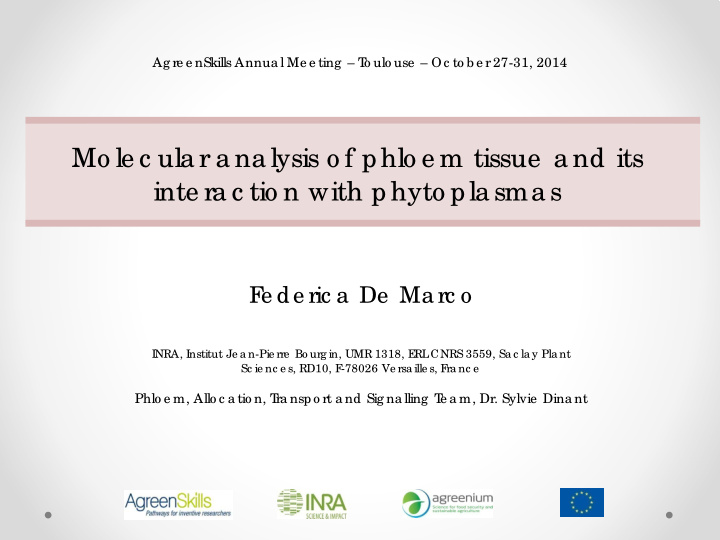



Ag re e nSkills Annua l Me e ting – T o ulo use – Oc to b e r 27-31, 2014 Mo le c ula r a na lysis o f phlo e m tissue a nd its inte ra c tio n with phyto pla sma s F e de ric a De Ma rc o INRA, Institut Je a n-Pie rre Bo urg in, UMR 1318, E RL CNRS 3559, Sa c la y Pla nt Sc ie nc e s, RD10, F -78026 Ve rsa ille s, F ra nc e Phlo e m, Allo c a tio n, T ra nspo rt a nd Sig na lling T e a m, Dr. Sylvie Dina nt
Phyto pla sma - phlo e m tissue inte ra c tio ns PHLOEM PHYTOPLASMAS Sink O 2 Photosynthesis Source From Sugio et al ., 2011 CO 2 Phloem sap Xylem sap 0.7 µm Sink SIEVE ELEMENT – Conducting cell PLANT DISEASE Infected grapevine. A, B: healthy C, D: infected tomato. Hren et al ., 2009 Pracros et al. , 2006
Pro je c t o utline Solanum lycopersicum ‘Ca. Phytoplasma solani’ COMPANION CELL SIEVE ELEMENT v SOURCE LEAF Organic Amino acids Acids Sugars Sugars Peptides n Effectors Effectors 0.7 µm PHYTOPLASMA OBJECTIVE: Decipher the trophic What are the plant genes modulated by the infection? relationships between What are the signalling pathways triggered by the infection? phytoplasmas and plant host What nutrients are required for the infection?
Pro je c t o utline Insights on tomato phloem physiology, carbohydrate transport and allocation Understanding of pathogenic mechanisms of ‘ Ca . Phytoplasma solani’ and of tomato response to the infection POTENTIAL APPLICATIONS Design new strategies of resistance to phytoplasmas Identification of marker genes to select resistant cultivars Use of marker genes to detect the presence of phytoplasmas
Recommend
More recommend